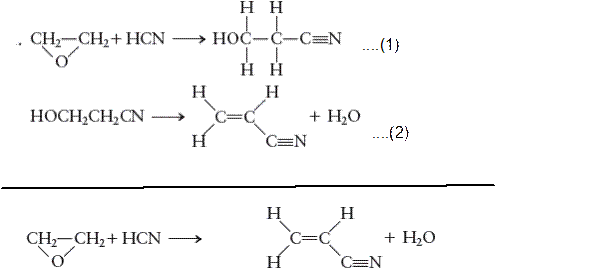
Concept explainers
(a)
Interpretation: The value of

Concept Introduction:
A chemical compound can be formed by either ionic bond or covalent bond between bonded atoms. The ionic compound is formed by opposite charge ions; cations and anions. The covalent compound is formed by sharing of electrons between bonded atoms.
The bond energy of a chemical bond can be defined as the energy required to break that chemical bond. The bond energy that is needed to break the bonds in reactant molecule and the energy released to form
(a)
Answer to Problem 56E
Explanation of Solution
Given:
 m:math display='block'>
m:math display='block'>
For the given reaction:
(b)
Interpretation: The value of
Concept Introduction:
A chemical compound can be formed by either ionic bond or covalent bond between bonded atoms. The ionic compound is formed by opposite charge ions; cations and anions. The covalent compound is formed by sharing of electrons between bonded atoms.
The bond energy of a chemical bond can be defined as the energy required to break that chemical bond. The bond energy that is needed to break the bonds in reactant molecule and the energy released to form chemical bonds in product can be used to calculate the
(b)
Answer to Problem 56E
Explanation of Solution
Given:
For the given reaction:
(c)
Interpretation: The value of
Concept Introduction:
A chemical compound can be formed by either ionic bond or covalent bond between bonded atoms. The ionic compound is formed by opposite charge ions; cations and anions. The covalent compound is formed by sharing of electrons between bonded atoms.
The bond energy of a chemical bond can be defined as the energy required to break that chemical bond. The bond energy that is needed to break the bonds in reactant molecule and the energy released to form chemical bonds in product can be used to calculate the
(c)
Answer to Problem 56E
Explanation of Solution
Given:
For the given reaction:
Want to see more full solutions like this?
Chapter 13 Solutions
EBK WEBASSIGN FOR ZUMDAHL'S CHEMICAL PR
- Calculate the pH and the pOH of each of the following solutions at 25 °C for which the substances ionize completely: (a) 0.000259 M HClO4arrow_forwardWhat is the pH of a 1.0 L buffer made with 0.300 mol of HF (Ka = 6.8 × 10⁻⁴) and 0.200 mol of NaF to which 0.160 mol of NaOH were added?arrow_forwardDetermine if the following salt is neutral, acidic or basic. If acidic or basic, write the appropriate equilibrium equation for the acid or base that exists when the salt is dissolved in aqueous solution. If neutral, simply write only NR. Be sure to include the proper phases for all species within the reaction. NaN₃arrow_forward
- A. Draw the structure of each of the following alcohols. Then draw and name the product you would expect to produce by the oxidation of each. a. 4-Methyl-2-heptanol b. 3,4-Dimethyl-1-pentanol c. 4-Ethyl-2-heptanol d. 5,7-Dichloro-3-heptanolarrow_forwardWhat is the pH of a 1.0 L buffer made with 0.300 mol of HF (Ka = 6.8 × 10⁻⁴) and 0.200 mol of NaF to which 0.160 mol of NaOH were added?arrow_forwardCan I please get help with this.arrow_forward
- Determine if the following salt is neutral, acidic or basic. If acidic or basic, write the appropriate equilibrium equation for the acid or base that exists when the salt is dissolved in aqueous solution. If neutral, simply write only NR. Be sure to include the proper phases for all species within the reaction. N₂H₅ClO₄arrow_forwardPlease help me with identifying these.arrow_forwardCan I please get help with this?arrow_forward
 Chemistry: Principles and PracticeChemistryISBN:9780534420123Author:Daniel L. Reger, Scott R. Goode, David W. Ball, Edward MercerPublisher:Cengage Learning
Chemistry: Principles and PracticeChemistryISBN:9780534420123Author:Daniel L. Reger, Scott R. Goode, David W. Ball, Edward MercerPublisher:Cengage Learning Chemistry: The Molecular ScienceChemistryISBN:9781285199047Author:John W. Moore, Conrad L. StanitskiPublisher:Cengage Learning
Chemistry: The Molecular ScienceChemistryISBN:9781285199047Author:John W. Moore, Conrad L. StanitskiPublisher:Cengage Learning
 ChemistryChemistryISBN:9781305957404Author:Steven S. Zumdahl, Susan A. Zumdahl, Donald J. DeCostePublisher:Cengage Learning
ChemistryChemistryISBN:9781305957404Author:Steven S. Zumdahl, Susan A. Zumdahl, Donald J. DeCostePublisher:Cengage Learning Chemistry: An Atoms First ApproachChemistryISBN:9781305079243Author:Steven S. Zumdahl, Susan A. ZumdahlPublisher:Cengage Learning
Chemistry: An Atoms First ApproachChemistryISBN:9781305079243Author:Steven S. Zumdahl, Susan A. ZumdahlPublisher:Cengage Learning Chemistry & Chemical ReactivityChemistryISBN:9781337399074Author:John C. Kotz, Paul M. Treichel, John Townsend, David TreichelPublisher:Cengage Learning
Chemistry & Chemical ReactivityChemistryISBN:9781337399074Author:John C. Kotz, Paul M. Treichel, John Townsend, David TreichelPublisher:Cengage Learning





